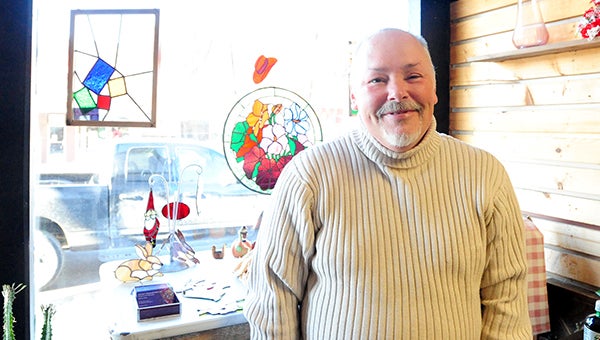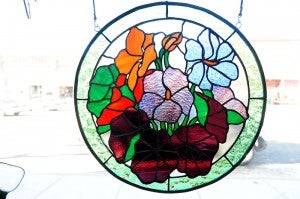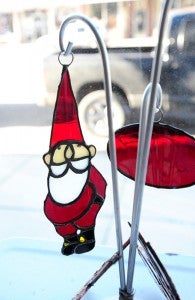Texas man just can’t stop staining glass
Published 11:10 am Tuesday, March 26, 2013

New Richland resident Jimmy Clem stands in front of stained glass pieces he has made over the last two years. Clem’s sister taught him the art and he has been addicted to making it since. –Brandi Hagen/Albert Lea Tribune
Growing up in what he called a “creative family,” 52-year-old Jimmy Clem of New Richland learned to put his hands to work when he was just 5 years old.
His mother taught him to sew, and by age 12 he was rebuilding the sewing machines.
A Texas native, Clem moved to New Richland about two years ago and started making and selling stained glass out of a shop owned by his friend, Trish Buyuk.
Clem learned the art from an older sister, Karen, who lived in Minnesota for a couple of years before the winter season drove her to move back to Texas. Due to a medical condition, Karen was unable to continue making stained glass herself and left her equipment in Minnesota for Clem to use.
Thinking back to his first piece, Clem estimated it was made up of only four or five pieces.
“It wasn’t like anything I’d ever accomplished,” Clem said. “It was just an exhilarating thing.”
Creating stained glass pieces became an addiction to Clem who picked up the art as something to calmly entertain his time as he was recovering from a heart attack and triple bypass surgery.
“I dabbled in it a couple times throughout the years, but it stuck at that point,” Clem said.
Clem estimated he spent 17 to 18 hours a day working with glass.
“I literally couldn’t stop,” Clem said. “It was truly an addiction.”

In order to make a piece of stained glass, it takes many different colors and textures of glass to get the right look as seen here in the different flowers.
Over the last year, Clem estimated he has made more than 200 ornaments in addition to larger work including windows for homes.
Each piece of art Clem makes gets a title whether the owner of the piece knows it or not, and if asked to recall the pieces he’s given away or sold, Clem said he can.
“They’re like little kids to me,” he said. “When I give them away I never forget the work I put in.”
The work that goes into making even a small ornament can add up quickly.
To make a piece of stained glass, Clem first chooses individual pieces of colored glass, then cuts, grinds and solders them into his vision.
Most often, Clem travels to a store in Sleepy Eye to find the perfect piece of glass. When he goes, he looks for a specific color and texture to fit his needs — a task that isn’t as easy as it sounds. Clem said no two pieces of glass are the same exact color and to an untrained eye, colors may look the same.
He estimated colored glass is priced anywhere between $10 a square foot up to hundreds of dollars per square foot.
“You can spend as much as you want, you can spend as little as you want,” Clem said. “I’ve found beauty in both kinds of pieces. Sometimes rough beauty is even better than refined beauty.”
Clem said he has had days where he spends six or seven hours at the store in Sleepy Eye looking for the right pieces of glass.
“The glass talks to me,” Clem said. “Out of the thousands and thousands of pieces of glass that are in there, something in there will grab my eye and from there it just simply builds.”
Clem said there are times when he goes places and people see his work or photos of his work they start to talk to him about the technical side of the piece.
“They talk to me in jargon that is way over my head,” Clem said. “I’m just a simple person. I’m not professionally trained so a lot of the stuff I do is just simply flying by the seat of my pants and the advice of other people.”
Clem said ever since people in the area started seeing his work hanging in the shop window on Broadway he hasn’t been able to keep it in stock.
“It tickles me,” Clem said. “When I drive around town and I see a piece hanging, it hits me very very warm. I know I’ve done what I can to get them what they want.”
There is one piece, though, that Clem keeps for himself.
The piece titled “Life After People” is made up of vines, a broken trellis and overgrown flowers and leaves. The work hangs in Clem’s bedroom. It was a piece Clem had done three months into his new hobby and couldn’t get rid of it.
“I don’t know why that piece does it for me; it’s not by far the hardest piece I’ve done, but it’s like it’s supposed to be with me,” he said.
Besides selling his work, Clem also makes sure to donate pieces to raffles for benefits and to food shelves.
“You have to give back,” Clem said. “It’s those people that have basically given you everything.”
After almost two years, Clem still works on pieces six days a week, but has learned when he needs to take time and walk away from it for a while.
And as long as the community keeps appreciating what he does, Clem said he doesn’t have plans to ever stop, but he said there are plans to sell his pieces out of his home instead of out of his friend’s shop.



